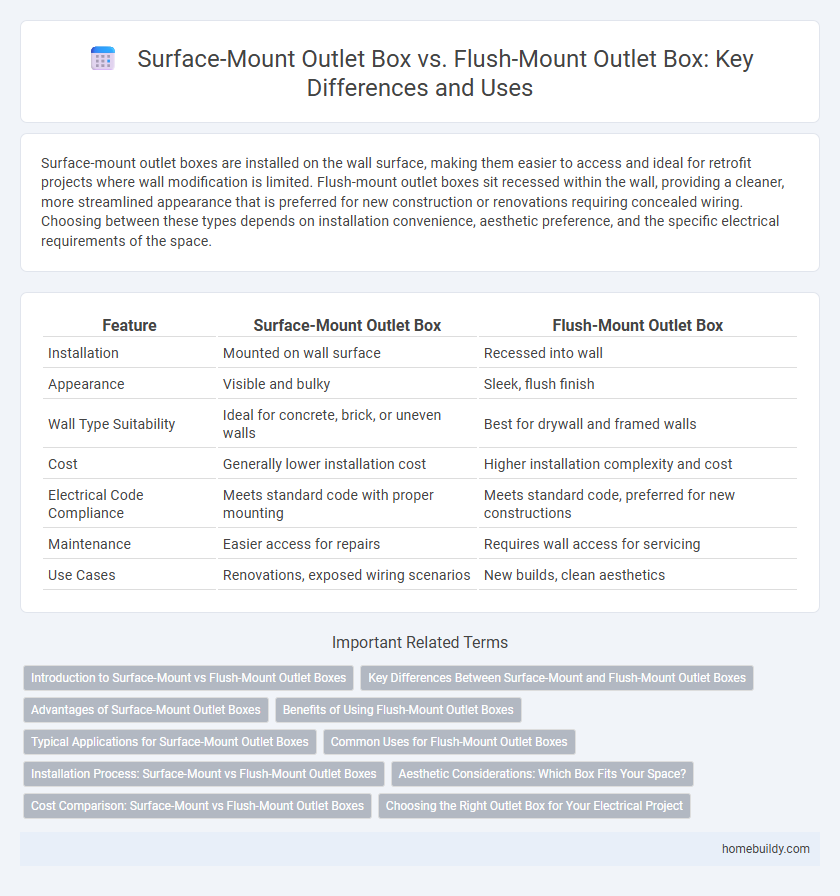Surface-mount outlet boxes are installed on the wall surface, making them easier to access and ideal for retrofit projects where wall modification is limited. Flush-mount outlet boxes sit recessed within the wall, providing a cleaner, more streamlined appearance that is preferred for new construction or renovations requiring concealed wiring. Choosing between these types depends on installation convenience, aesthetic preference, and the specific electrical requirements of the space.
Table of Comparison
| Feature | Surface-Mount Outlet Box | Flush-Mount Outlet Box |
|---|---|---|
| Installation | Mounted on wall surface | Recessed into wall |
| Appearance | Visible and bulky | Sleek, flush finish |
| Wall Type Suitability | Ideal for concrete, brick, or uneven walls | Best for drywall and framed walls |
| Cost | Generally lower installation cost | Higher installation complexity and cost |
| Electrical Code Compliance | Meets standard code with proper mounting | Meets standard code, preferred for new constructions |
| Maintenance | Easier access for repairs | Requires wall access for servicing |
| Use Cases | Renovations, exposed wiring scenarios | New builds, clean aesthetics |
Introduction to Surface-Mount vs Flush-Mount Outlet Boxes
Surface-mount outlet boxes are installed on the surface of walls, making them easier to access and ideal for retrofit projects where wall modifications are limited. Flush-mount outlet boxes are recessed into the wall, providing a seamless, low-profile appearance that is preferred for new construction or renovations prioritizing aesthetics. Both types serve to protect electrical connections, but the choice depends on installation requirements and design preferences.
Key Differences Between Surface-Mount and Flush-Mount Outlet Boxes
Surface-mount outlet boxes are installed on the wall's surface, making them easier to access and ideal for retrofit projects, while flush-mount outlet boxes are recessed into the wall, providing a cleaner, more streamlined appearance. Surface-mount boxes require less wall modification and are typically used in settings like basements or utility rooms, whereas flush-mount boxes are preferred in finished interiors for aesthetic reasons. The choice between these two types hinges on installation complexity, wall structure, and desired visual outcome.
Advantages of Surface-Mount Outlet Boxes
Surface-mount outlet boxes offer easier installation on walls where cutting or opening is difficult, ensuring minimal damage to existing structures. They provide superior accessibility for maintenance and upgrades, making them ideal for retrofit or renovation projects. Their external positioning also allows for better heat dissipation, reducing the risk of overheating in electrical systems.
Benefits of Using Flush-Mount Outlet Boxes
Flush-mount outlet boxes offer a sleek, streamlined appearance by sitting flush with the wall surface, reducing protrusions and enhancing room aesthetics. They provide better protection for wiring and devices against physical damage and accidental disconnection, improving overall safety. Flush-mount boxes also facilitate easier installation of wall fixtures and switches, ensuring a secure fit and reliable electrical connections.
Typical Applications for Surface-Mount Outlet Boxes
Surface-mount outlet boxes are commonly used in retrofit projects and commercial buildings where walls cannot be easily altered, providing easy access for electrical connections. They are ideal for installations on concrete, brick, or finished surfaces requiring minimal wall modification. These boxes also suit industrial environments where durability and quick maintenance access are essential.
Common Uses for Flush-Mount Outlet Boxes
Flush-mount outlet boxes are commonly used in residential and commercial buildings where a clean, finished appearance is desired, as they are installed within the wall, allowing outlets and switches to be flush with the surface. These boxes are ideal for drywall or plaster walls, enabling easy integration with wall coverings and reducing the risk of snagging cords or devices. Flush-mount boxes are preferred in living rooms, bedrooms, and offices where aesthetics and seamless wall surfaces are important.
Installation Process: Surface-Mount vs Flush-Mount Outlet Boxes
Surface-mount outlet boxes install externally on walls, requiring minimal wall modification and are ideal for retrofit or concrete wall applications. Flush-mount outlet boxes require cutting a precise hole into the wall, allowing the box to sit flush with the surface for a cleaner, more integrated appearance. Surface-mount boxes offer faster installation with easier access, while flush-mount boxes provide a streamlined look but demand more labor and wall preparation.
Aesthetic Considerations: Which Box Fits Your Space?
Surface-mount outlet boxes sit on the wall surface, projecting outward and offering a more industrial or utilitarian look ideal for exposed brick or concrete walls. Flush-mount outlet boxes are recessed into the wall, providing a sleek, minimalist appearance that blends seamlessly with drywall or finished surfaces. Choosing between the two depends on the desired aesthetic harmony with your interior design and the architectural style of the space.
Cost Comparison: Surface-Mount vs Flush-Mount Outlet Boxes
Surface-mount outlet boxes generally cost less due to simpler installation and reduced labor time compared to flush-mount outlet boxes, which require wall cutting and finishing. Flush-mount outlet boxes provide a cleaner, more professional look but incur higher expenses from additional materials and skilled labor. Choosing between surface-mount and flush-mount depends on budget constraints and desired aesthetics.
Choosing the Right Outlet Box for Your Electrical Project
Surface-mount outlet boxes are ideal for projects requiring easy access and installation on existing wall surfaces, providing flexibility in wire routing without wall modification. Flush-mount outlet boxes fit within wall cavities, offering a cleaner appearance and better protection for wiring in new constructions or renovations with open studs. Selecting the appropriate outlet box depends on wall type, project scope, and aesthetic preferences to ensure compliance with electrical codes and long-term durability.
Surface-mount outlet box vs Flush-mount outlet box Infographic

 homebuildy.com
homebuildy.com